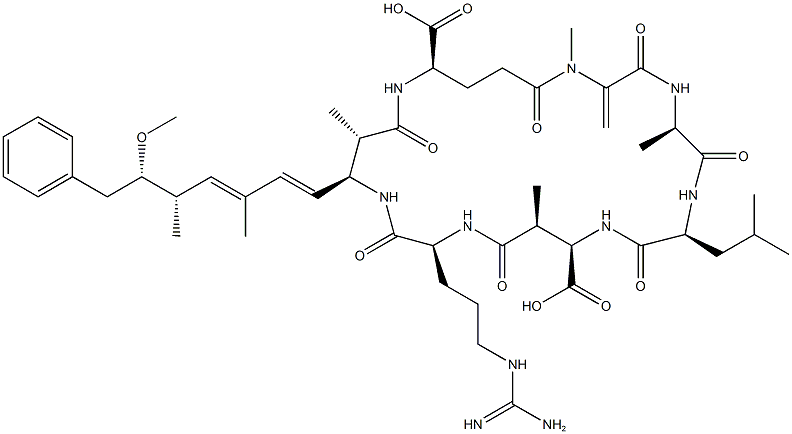Microcystins are hepatotoxic cyclic heptapeptide toxins produced by cyanobacteria. They are responsible for periodic poisonings of humans and livestock drinking fresh water where the blue-green algae are endemic. Microcystin-LR is a selective inhibitor of protein phosphatase 2A (PP2A) (IC50= 0.04 nM) and will completely inhibit this enzyme without affecting PP1 when used at a concentration of 0.5 nM. The PP1 IC50 is about 1.7 nM. Microcystins are at least 10 times more potent as serine/threonine PP inhibitors than okadaic acid, another microalgal toxin also used for this purpose.
ChEBI: Microcystin-LR is a microcystin consisting of D-alanyl, L-leucyl, (3S)-3-methyl-D-beta-aspartyl,L-arginyl, 2S,3S,4E,6E,8S,9S)-3-amino-4,5,6,7-tetradehydro-9-methoxy-2,6,8-trimethyl-10-phenyldecanoyl, D-gamma-glutamyl, and 2,3-didehydro-N-methylalanyl residues joined into a 25-membered macrocycle. Produced by the cyanobacterium Microcystis aeruginosa, it is the most studied of the microcystins. It has a role as a bacterial metabolite, an EC 3.1.3.16 (phosphoprotein phosphatase) inhibitor, a xenobiotic and an environmental contaminant.
A poison by ingestion and inhalation.
A poison by ingestion, inhalation,intraperitoneal, and intravenous route. Experimentalreproductive effects. When heated to decomposition itemits toxic vapors of NOx.
1) Rinehart?et al.?(1988),?Nodularin, microcystin, and the configuration of Adda; J. Am. Chem. Soc.,?110?8557
2) Honkanen?et al. (1990),?Characterization of microcystin-LR, a potent inhibitor of type 1 and type 2A protein phosphatases;?J. Biol. Chem,?265?19401
3) Runnegar?et al.?(1995),?Microcystin uptake and inhibition of protein phosphatases: effects of chemoprotectants and self-inhibition in relation to known hepatic transporters; Toxicol. Appl. Pharmacol.,?134?264
